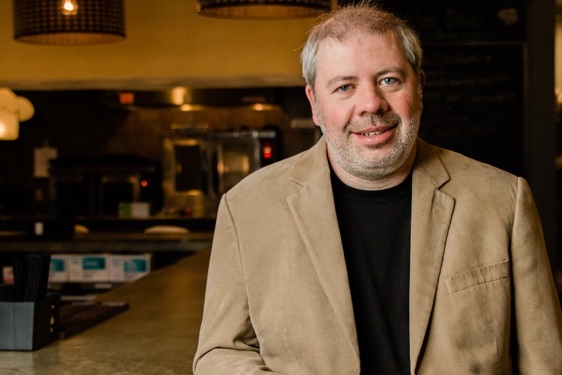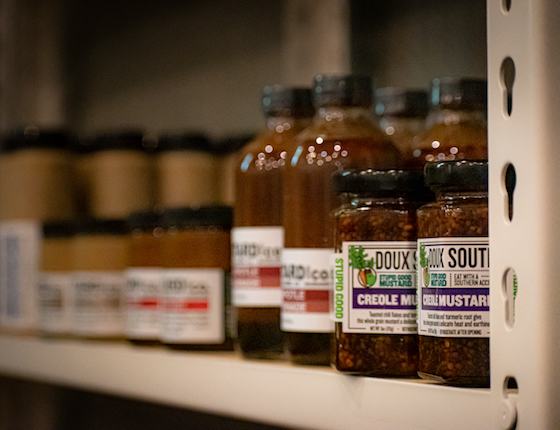After eight years, Chris Ortego finally had Cotton Blues, his restaurant in Hattiesburg, Mississippi, right where he wanted it: He had pulled back from the original upscale menu and found the right mix of dishes like fried shrimp po’boys, praline-blackened catfish and pimiento bacon burgers to attract customers. Weekend brunch regularly lured crowds for blueberry cream cheese pancakes and fried green tomato Benedicts, and the restaurant’s cheesecake had become so popular that he was selling it in local retail shops — and was poised for national expansion.
But everything changed on March 15, during a particularly crowded brunch service. Ortego told HOTELS sister publication, Plate, us why he shut down his restaurant that night (10 days before the state of Mississippi mandated it), how the pandemic affected his retail product plans, and what’s behind his decision to convert the restaurant into a full-service food market with dining and a full bar, plus an outdoor picnic area with games.

What made you decide to close Cotton Blues?
I had a Sunday brunch in March filled with college students who had been to Mardi Gras and on Bourbon Street in New Orleans, and I felt really uncomfortable. We closed that day and were the first ones in the area to do so. We had only had a few cases of coronavirus at that point, but I could see that New York was on fire. At the time, I thought if we didn’t go home, all small businesses would die a death by a thousand cuts.
I’m a big believer in being the change you want to see, and I thought if I set the pace in shutting down, it might encourage others to do so. I thought we’d all go home for two or three weeks and get over this as fast as possible and go back to normal life. Little did I know we’d still be talking about it in June.
So I sent everyone home for two weeks. We immediately went to family meals-to-go because I figured that’s what people would be looking for and what they needed. I also knew I’d have to lay off some staff and I knew unemployment was going to be a disaster as far as getting through to anyone. I wanted some of my chefs to be some of the first people in line to make those phone calls. I wanted to let my staff know what they needed to do in order to protect themselves, because I knew I couldn’t protect them.
What happened to your retail plans for the cheesecake when COVID hit?
When we launched the cheesecake company two years ago, we built a 15,000-square-foot production kitchen, and were in about 75 stores. We had been doing it out of the restaurant, so it was time to scale up. We were about go into 700 retail stores in the region when the country began to shut down. When grocery stores were scrambling to get bread, I couldn’t talk to anybody about [selling] high-end cheesecake. But just a few weeks ago we teamed up with a website that partners with restaurants to ship anything [to consumers]. It’s helping us sell cheesecakes, and we now have national shipping presence. It’s been one of the byproducts of a bad situation.
Why didn’t you reopen the restaurant when Mississippi allowed it in early May?
I felt it was important to be the safest restaurant to open and not the first, but I understand anybody who’s worried about losing their business and paying their bills. I have a friend who has a more of college bar and the kids were ready to get out. I think he’s doing pretty well. I’m on the side of town with families, so I knew it wouldn’t work for me. And it depends on your concept. If you only sell burgers, it’s a lot easier to get lean. But if you have a large menu and restaurant, it’s more difficult. I also have a large staff and I didn’t know how I could just look at some managers and say, “I’m choosing to keep you and not you.”
After lots of discussions, we decided to completely reinvent ourselves. At only 50% occupancy, I’d have to have people in my building from 7 a.m. to 11 p.m. to survive financially, so I needed to become more of a retail store. If you’re a department store, you have a steady flow of people throughout the day. I needed to use all 10,000 square feet of my restaurant, and not half of it, because my mortgage isn’t half. We needed to figure out how to get people to spend money all day in the restaurant, not just during lunch and dinner peaks. That’s the biggest challenge we’ll face.
And I figured that rather than open up at 50% capacity and do a 30-day quick grab of money opening and have to make a tough decision 30 days later, I’d rather reinvest $60,000 of my own money into renovations. I’m using our CARES Act money to cover labor for a month while we try something new. I’m working on reinventing the concept, putting my people back to work, retraining and retooling. It’s hard to reinvent yourself overnight, but I only have one restaurant, so I could really rally the troops. My whole staff is stepping up. I told them I had to have 100% buy-in to make this work.

You are turning the restaurant into a combined dining and retail space. Can you explain what it will look like?
We’re going to do grab-and-go brioche breakfast sandwiches, baked goods, salads, sandwiches and frozen items. We’re going to have a tasting station with a chef behind Plexiglas who will serve soups during the day and one-pot meals at night. You can safely taste, take it to go, or eat it here, indoors or out.
We’re offering meals to go, which will be on disposable sheet pans and covered in plastic — something like a chipotle raspberry-marinated salmon with baby potatoes and asparagus that goes in the oven for 20 minutes. I’m going to have a lot less cooks handling the food; we’re not trying to prep an enormous menu. For takeout orders, my father helped me build outdoor kiosks where people can drive by and pick up pre-paid orders. Our [former] private dining room is where we’ll sell fresh produce; local items like jams, cheeses, salsas, dips, candies and a lot more.
How will you handle dine-in service?
We’re opening half of our dining room for socially distanced seating and offering counter service-style with disposable menus. We’re using plastic plates, cups and utensils, but as things become safer, we may go back to silverware. I get that you can’t cut a rib-eye with a plastic knife, but what bothers me is if you’re using silverware and somebody is asymptomatic and puts a spoon in their mouth, and then you have someone bus it. OK, maybe they are wearing gloves and a mask, but then you bring it back to the dish pit, and there’s one poor dishwasher spraying that bin of silverware, and that water is splashing up in his face. I don’t care if he has a mask on or not, he could have a whole bin of silverware that could be contaminated.
How are you changing your outdoor space?
We’re using 20 spaces of our parking lot to build a 4,500-square-foot picnic area surrounded by a fence and box hedging. I didn’t want to just have a green space in the middle of a parking lot; I wanted it feel like a little oasis. We’ll have picnic tables, sunshades, pergolas, and fans. I needed permanent shade structures because we live in a hurricane and tornado-heavy area and are prone to pop-up thunderstorms. I found a company that makes artificial turf, and we drove down to Gulfport to pick up an old football field. It took a forklift and 12 guys to unroll 5,000 pounds of rolled up turf. We’re also still figuring out lawn games, and may do something like giant corn hole with throw pillows. Luckily, our city’s cooperating with some of the building codes and making the process a little easier because they know that businesses are in trouble and they need us.
How do you feel about making such a big transition?
I don’t know if it’s the right decision, but I feel good about it. I do think it’s the direction we were going in already, but it’s nerve-wracking. I could have easily shut the place down and lived off the cheesecake company. But I have staff that’s have been with me for eight years, and I just didn’t have it in me to tell them to fend for themselves in this labor market. I think it’s been proven over these last two months that the hospitality industry might not be the backbone of the economy, but we’re definitely a few vertebras. If we do have a massive economic downturn, restaurants are still going to be crucial to feeding people, but we’re going to have to feed them in a more affordable way. The $15 sit-down restaurant hamburger is probably not going to fly they way it used to.
If I knew exactly what was going to happen, there’d be easier ways to make money than running a restaurant. I’m a believer in listening to doctors. But doctors will always air on the side of caution, so it’s trying to find that balance, you know? We were something for everyone before we closed, and we’re trying to be that way in the future. We will get a vaccine, it will get better, but how long will it take? We don’t know, but for now we want to be flexible, nimble, and prepared if we have to transition again. So there’s definitely some anxiety, but I feel pretty confident. I think the concept fits our world and what it’s going to be.
This story was originally published on HOTELS’ sister publication, plateonline.com.
